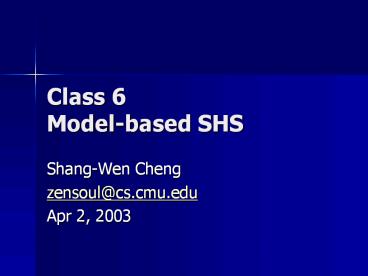Class 6 Model-based SHS - PowerPoint PPT Presentation
Title:
Class 6 Model-based SHS
Description:
Class 6. Model-based SHS. Shang-Wen Cheng. zensoul_at_cs.cmu.edu. Apr 2, 2003. Papers ... How is this related to SHS? Model-based Self-repair. Main idea ... – PowerPoint PPT presentation
Number of Views:31
Avg rating:3.0/5.0
Title: Class 6 Model-based SHS
1
Class 6Model-based SHS
- Shang-Wen Cheng
- zensoul_at_cs.cmu.edu
- Apr 2, 2003
2
Papers
- Gross, Gupta, Kaiser, Kc, Parekh (CDSA01)
- An Active Events Model for Systems Monitoring.
- Combs, Vagel (WOSS02)
- Adaptive Mirroring of System of Systems
Architectures. - Bond, Sud (CDSA01)
- Service Composition for Enterprise Programming.
- How is this related to SHS?
3
Model-based Self-repair
- Main idea
- Use some abstraction as basis for problem
detection and adaptation - Variations
- Layer of system
- Models used?
- Externalized or internalized?
- Support multiple control models?
4
Taxonomy?
- Application Domains
- Networks, Distributed Systems
- Mobile Systems
- Ubiquitous Computing
- Biology Simulation
- User Interfaces
- Collaborative Computing
- Games
- Tools, Mechanisms, Techniques
- Architectural models
- Algorithms/code-based
- Formal models
- Genetic algorithms/alternative models
- Agents
- Economic theory
- Goals
- Improve system performance/Resource usage
- Improve user experience reduce user distractions
- Improve dependability
Model-based adaptation Typically, distributed
collaborative applications Models events,
agents, contracts, policy System quality
attributes such as performance, reliability, etc.
5
Four General Requirements for SHS
- MonitorObserve the running system and abstract
observed behavior. - DetectionContinuously check constraints via
explicit(?) run-time models. - ResolutionDetermine the cause of constraint
violation and choose a adaptation strategy. - AdaptationAdapt the system using verified
change strategies.
6
ActEvents Approach
- Application domain
- Distributed system with focus on monitoring
- Whats the model?
- Active events
- Notion of anomaly and time window
- Goals
- Flexibility and Efficiency
- Mechanism
- XML mobile code
- Monitor
- Use system of probes to get raw information out
- Abstract that information using gauges
- Detection
- SmartEvent showing anomalous condition
- Resolution
- Is there any?
- Adaptation
- Deploy worklets
7
Adaptive Mirroring Approach
- Application domain
- Enterprise, distributed applications
- Whats the model?
- Adaptive mirror contracts
- How is this different from an architectural
model? - Goals
- Reliability and scalability
- Mechanism
- Agents
- Monitor
- Probes gauges
- Detection
- Constraint directive violation
- Does hint play a part?
- Resolution
- Search of eligible service substitutes
- Adaptation
- Service substitution
- How does it occur?
8
ODSI Approach
- Application domain
- Enterprise applications, with focus on middleware
- Whats the model?
- Enterprise policy
- Dynamic directory?
- Goals
- Reliable flexible interoperation
- Mechanism
- Peers
- Monitor
- Implicit, when peers get service requests
- Detection
- A requested service is unavailable or violates
enterprise policy - Resolution
- Determine where to reroute or request service
- Adaptation
- Reroute service or request service provision
9
Shortcomings?
- Are models explicit and well-defined?
- How reusable are the components of the various
approaches?
10
Comments?
- The End































